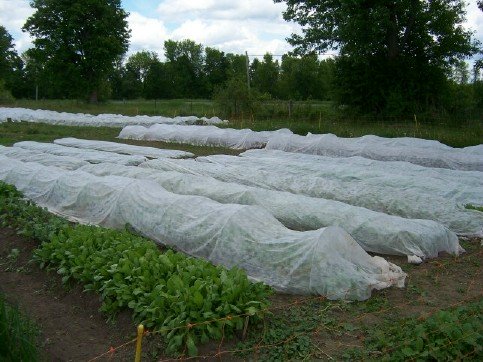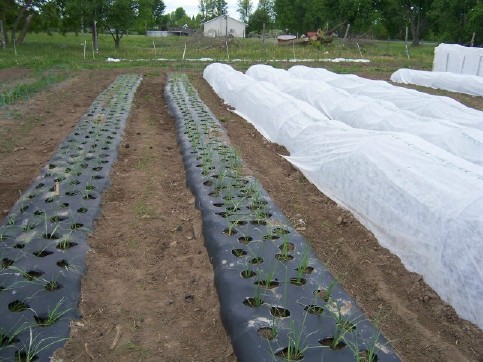Floating row cover is the organic gardener's best friend
Floating row cover is made of a light spun polyester fabric, and is used for both frost protection and as a physical barrier against insects.
Row cover is permeable to air and water, and typically transmits about 85% light, depending on the weight of the fabric. We use a LOT of floating row cover in the New Terra Farm market garden; here's why we use it:
- Season extension and protection for early crops - we are able to put hardy vegetables such as broccoli, cabbage, kale, spinach and many other greens out in our garden a full month before our last frost date. This gives us a great 'head-start' on the season. I have never lost a plant protected by row cover.
- Insect protection - properly installed floating row cover makes a physical barrier against flying insects e.g. cabbage moth, cucumber beetle, leek moth. We would be unable to get a good yield from many crops without it.
- No hardening off - my transplants move from the plant starting room to one of the unheated greenhouse to the outdoor garden under row cover, WITHOUT hardening off. My experience says the floating row cover provides enough protection against cold and especially wind that hardening off is not required.
 Floating row cover keeps the bugs away and frost at bay
Floating row cover keeps the bugs away and frost at bayI also use row cover on my cold frames; because they are permeable, the frames will not overheat as they would if covered by glass or plastic.
This is a good use for pieces if row cover that are too small for your garden beds. Caution: the row cover will let rain in, so if a heavy rain is predicted cover your cold frames with something impermeable to prevent flooding.
A couple years ago I figured how to grow meslcun (micro salad mixes) with less work. I started the seeds in trays with about 3/4 inch of damp ProMix.
I kept them covered with clear tray lids until they germinated, then put the trays out on pallets in a semi-shady area, and covered them with floating row cover to keep out bugs and falling debris. This worked very well, a bumper crop of salad greens with no weeds or bugs.
 I grow mesclun in a soil-less mix (ProMix)and protect the trays with row cover.
I grow mesclun in a soil-less mix (ProMix)and protect the trays with row cover.I even use scraps of row cover to make my
compost tea
I put a couple shovels-full of good aged compost in a piece of row
cover, tie it up, and drop in my compost barrel with the water. The row
cover makes a great strainer for the tea.
Here's the system that works for me:
- Our raised garden beds are 50-feet long and about 30-inches wide
- We use 72-inch lengths of wire to make hoops for row cover supports
- We insert the wire hoops about every 4 feet along the beds
- We tie the row cover supports together using garden twine; this helps to keep them stable
- we cover the hoops with 83-inch wide row cover, and bury the edges in the soil on both sides and the ends of the raised bed
 Film mulch and row cover: the gardener's secret weapons
Film mulch and row cover: the gardener's secret weaponsWe also use the row cover on beds that we cover with biodegradable film mulch - just remember to put your drip irrigation down before you place the mulch.

The consumer demand for fresh local organic food has never been higher. Bad news on the supply chain is good news for local growers.
Get my free Organic Market Gardener Start-up Guide and see if this is the right time to launch your CSA market garden business. Download it here.
More free reports here
- Home Page ›
- Sustainable Organic Farming ›
- Floating Row Cover





